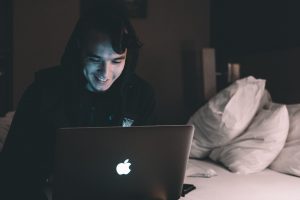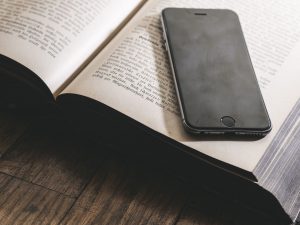Night mode for LED displays – does it really work?


In today’s world, LED displays are omnipresent. We use them for computers, smart phones, e-book readers and television. And we use all these appliances until late at night, often right before we go to bed. After all, we usually have more work than we can cope with in an eight hour day, and reading a nice book before turning in has long been a recipe for a good nights sleep. But this recipe seems to loose its efficiancy. Every third German, so the sleep report by Techniker Krankenkasse, does not sleep well. Pressure from work and private life are often discussed as reasons, and rightly so, but there is also a technical problem here: LEDs.
It has been shown in several studies, that blue light from LED devices reduces the production of melatonin, the hormone that helps us go to sleep at night. Anne-Marie Chang and her colleagues studied the effect of light-emitting ebook readers compared to printed books in 12 young adults. The participants read ebooks for about 4 hours prior to bedtime on five consecutive nights. On the last of these nights, the differences to the nights with reading a printed book were obvious: the participants had a 55% reduction in melatonin levels, needed about 10 minutes longer to go to sleep and had a reduction of REM sleep of about 10 minutes. Using an ebook-reader made the participants feel less sleepy in the evening, but they found it harder to get up in the morning. They reported that it took them hours longer to “fully wake up”. The melatonin levels showed that the biological rhythm after five days of ebook-reading was delayed by 1.5 hours compared with the nights reading a printed book.

The displays of the tested ebook-readers, similar to other LED displays, emited bluish-white light with peaks at 452 nm, which is also the peak wavelength for our circadian system. This bluish-white light has an impact on the inner body clock, telling the brain that it is day even late at night. It thus delays the body clock. This delay can be a problem for adolescents and young adults. It has been shown that at this age, the body clock is delayed in comparison to the body clock of adults. If you ever wondered why teenagers will not get up in the early without being forced and why they pretty much look like zombies on their way to school, this your answer. Today, teenagers spent many hours in front of LED displays, using them for school work, communication and recreation. A further delay of their biological rhythm, caused by the blue-white light of the LED-displays, makes their problem of getting up early enough for school even worse.
Manufacturers of LED devices have already reacted. There are software solutions out there to filter out the blue light from your computer screen, of which the best know is probably the free programme f.lux. Many devices are equipped with night modes that use a warmer, more yellowish light for the screens. Now a team of researchers around Mariana Figueiro from the Rensselaer Polytechnic Institute in Troy, USA, has tested the effect of the iPad Night Shift mode. Twelve participants were observed for four single nights. The iPad night shift allows the user to choose from a colour temperature between ‘less-warm’ (5997 K) and ‘more-warm’ (2837 K), in the study both extremes were tested. Participants were also treated with Blue Light Goggles as a high circadian stimulus and Orange Goggles which would not suppress melatonin production.
The researcher were indeed able to see an effect of the Night Shift mode. Compared to the blue light from the goggles, melatonin supression was smaller. However, melatonin levels after one hour of using the Night mode screen were lower, no matter what colour temperature had been chosen. This indicates that even in Night Shift mode, the iPad does interfere with melatonin and thus with the biological rhythm of the user. Therefore, the authors suggest to additionally lower the light intensity of the iPad, to reduce the impact on the body clock.

The development of applications like the Night Shift mode is definitely a step into the right direction. But as Mariana Figueiro and her team point out, it might not be enough to change the spectrum and colour temperature of the LED display, but also its brightness. And, last but not least, we should still be careful in using LED displays in the hours before bedtime, escpecially in children and adolescents, because they are more sensitive to light and changes in their biological rhythm. This can be a healthy excuse not to work on a computer till late at night. And maybe the good old printed book isn’t that outdated yet.
Sources:
Chang, A. et al., 2015. Evening use of light-emitting eReaders negatively affects sleep , circadian timing , and next-morning alertness. Proceedings of the National Academy of Sciences of the United States of America, 112(4), pp.1232–1237
Nagare, R., Plitnick, B. & Figueiro, M., 2018. Does the iPad Night Shift mode reduce melatonin suppression? Lighting Research & Technology, 147715351774818